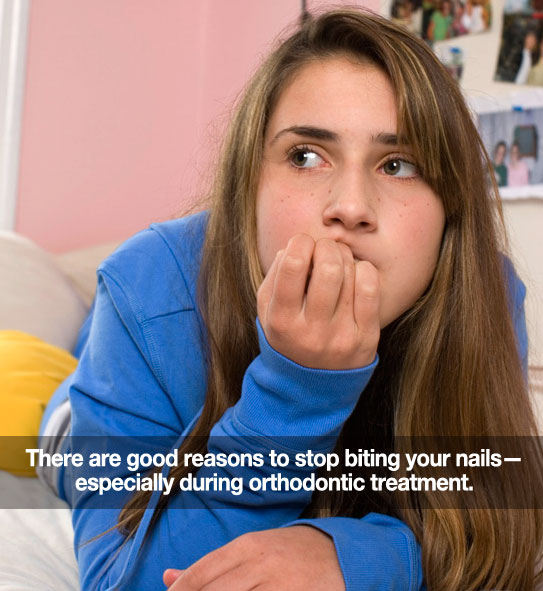Nail Biting Can Be Hard On Your Teeth AND Your Braces
July 13th, 2018

WHETHER IT’S DONE consciously or unconsciously, nail biting habits affect people of all ages. On the surface, nail biting may not seem like a big deal. However, fairly severe consequences can result in both oral and overall health problems. And as if that wasn’t enough, it can also cause complications during your orthodontic treatment.
Nail Biting’s Effects On Your Teeth
- Nail biting can crack, chip and wear down teeth. Your front teeth are lot different from your back teeth in terms of functionality. They aren’t designed for gnawing or chewing.
- Nail biting can shift tooth alignment and damage existing orthodontic treatment.
- Nail biting risks gum tissue damage. Bitten nail pieces can easily tear into your gum tissue increasing the risk of gum disease and eventual tooth loss.
- Nail biting can be expensive. The Academy of General Dentistry estimates that nail biters incur an additional $4,000 in future dental repairs.
- Nail biting can break your braces. The hard nail on your finger when pressed up against your orthodontic bracket with biting force could cause your orthodontic bracket to break and come loose.
Did you know that teenagers are actually the most common nail biters? While 25 percent of young adults bite their nails and only 5 percent of older adults bite their nails, as many as 45 percent of teenagers have this habit. And for teenagers with braces, it can cause problems.
Nail Biting’s Effects On Your Health
Think about the most germ-concentrated areas of your body — your mouth and hands. You can imagine what happens when those two areas are in constant contact. And when there are even tiny, tiny breaks in the skin, germs get a free hall pass to your bloodstream. Yuck.
Tips For Quitting
Maybe you’ve always wanted to quit, but it hasn’t worked yet. Here are a few tips:
- Keep your nails looking nice. It will help motivate you to leave them alone.
- Enlist friends. Sometimes it helps to have someone remind you when you’re biting.
- Notice your trigger(s). Anxious? Bored? Learn to deal with these emotions in other ways.
- Carry a nail file and clippers. If you crack a nail or snag it, you can make repairs without biting.
- Treat your nails. There are many awful tasting products — designed for this purpose — that you can put on your nails to really deter you.
Do You Have Any Helpful Quitting Ideas To Add?
Do you struggle with biting your nails? Does someone you love bite his or her nails? We hope the content of this post has helped. Let us know if there is anything else our team can do to help, or if you have other questions. If you have any tips for quitting, share them below or connect with us on our Facebook page. We’re always excited to hear from you!










